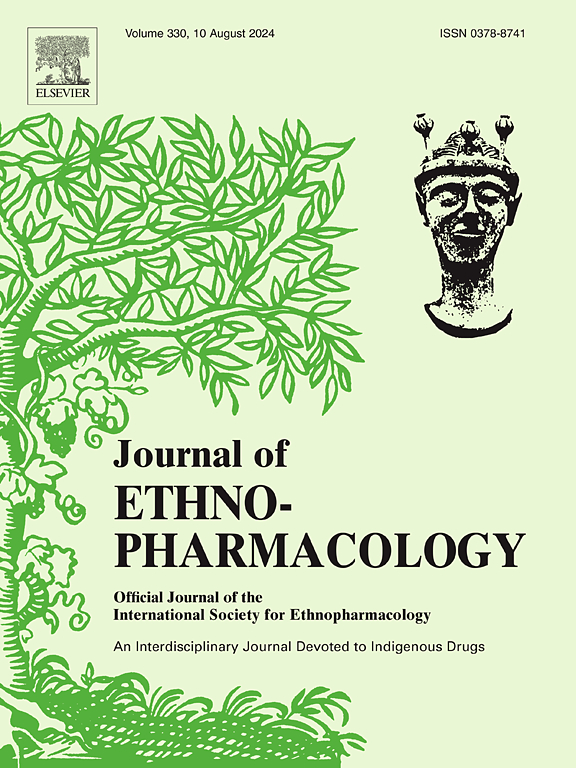Sphenocentrum jollyanum (Pierre) aqueous leaf extract demonstrates anti-inflammatory and mitochondrial-restorative influences while modulating apoptosis in streptozotocin-induced diabetic rats
IF 4.8
2区 医学
Q1 CHEMISTRY, MEDICINAL
引用次数: 0
Abstract
Ethnopharmacological relevance
Sphenocentrum jollyanum (Pierre) is a medicinal plant native to West African countries, especially Nigeria and Ghana. The leaf of S. jollyanum is a traditional therapy for diabetes, erectile dysfunction, gastrointestinal disorders, and malaria. However, there is a paucity of information on the mitochondrial-restorative and apoptotic-modulating properties of S. jollyanum leaf.
Aim of the study
The anti-inflammatory, apoptotic-modulating, and mitochondrial-restorative effects of S. jollyanum were studied using diabetic Wistar albino rats induced with streptozotocin.
Methods
A high-fat diet (HFD) and a single dose injection of 10 mg/kg of streptozotocin (STZ) were used to induce type-2 diabetes model. Thirty-six (36) rats were randomly assigned into six groups as follows: Group 1 (normal diet + normal saline), Group 2 (HFD + 50 mg/kg STZ), Group 3 (HFD + 50 mg/kg STZ + 10 mg/kg glibenclamide), Group 4 (HFD + 50 mg/kg STZ + 50 mg/kg of S. jollyanum extract), Group 5 (HFD + 50 mg/kg STZ + 100 mg/kg of S. jollyanum extract), Group 6 (HFD + 50 mg/kg STZ + 200 mg/kg of S. jollyanum extract). Glucose levels (fasting) were monitored in the rats at a 48-h interval. After experimental treatment for 28 days, blood was collected via cardiac puncture into plain bottles. After differential centrifugation, serum was extracted into plain bottles for assessment of insulin, caspases 3 and 9 activity, as well as IL-1β, IL-6, CRP, and TNF-α levels. Liver mitochondria were isolated for mitochondrial ATPase activity, lipid peroxidation and mitochondrial permeability while liver and pancreatic tissues were prepared for histopathology using standard laboratory procedures.
Results
Induction of the Wistar rats with 50 mg/kg of streptozotocin increased fasting glucose, caspase 3, caspase 9, IL-1β, IL-6, TNF-α, CRP, troponin I, as well as increased mitochondrial permeability, mitochondrial lipid peroxidation, and mitochondrial ATPase activity significantly compared to the normoglycemic group and glibenclamide-treated group. This was also accompanied by pathological lesions in the liver and pancreas. Administration of S. jollyanum aqueous leaf extract significantly decreased mitochondrial ATPase activity, mitochondrial lipid peroxidation, caspase 3 and caspase 9 activity, and mitochondrial permeability, fasting blood glucose, IL-1β, IL-6, TNF-α, CRP, and troponin I levels in the diabetic rats, while significantly boosting serum insulin content (p < 0.0001).
Conclusion
S. jollyanum aqueous leaf demonstrates anti-inflammatory, mitochondrial-protective and apoptotic-modulating influences while reversing hepatic and pancreatic damage in diabetic Wistar rats.

求助全文
约1分钟内获得全文
求助全文
来源期刊

Journal of ethnopharmacology
医学-全科医学与补充医学
CiteScore
10.30
自引率
5.60%
发文量
967
审稿时长
77 days
期刊介绍:
The Journal of Ethnopharmacology is dedicated to the exchange of information and understandings about people''s use of plants, fungi, animals, microorganisms and minerals and their biological and pharmacological effects based on the principles established through international conventions. Early people confronted with illness and disease, discovered a wealth of useful therapeutic agents in the plant and animal kingdoms. The empirical knowledge of these medicinal substances and their toxic potential was passed on by oral tradition and sometimes recorded in herbals and other texts on materia medica. Many valuable drugs of today (e.g., atropine, ephedrine, tubocurarine, digoxin, reserpine) came into use through the study of indigenous remedies. Chemists continue to use plant-derived drugs (e.g., morphine, taxol, physostigmine, quinidine, emetine) as prototypes in their attempts to develop more effective and less toxic medicinals.
 求助内容:
求助内容: 应助结果提醒方式:
应助结果提醒方式:


